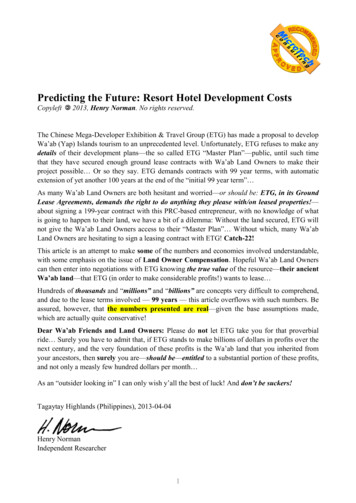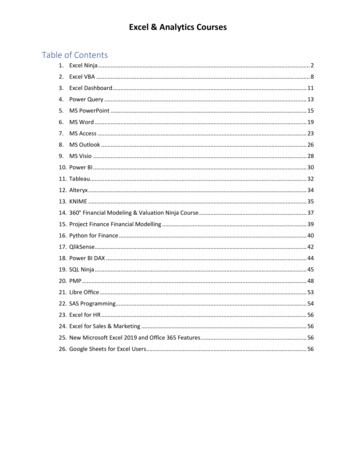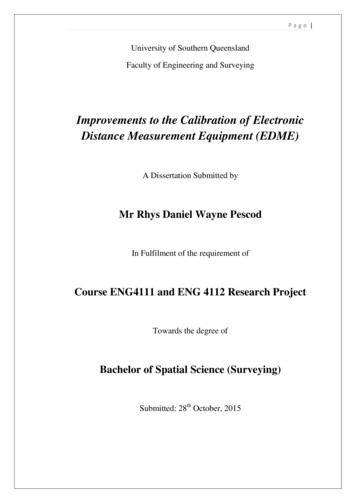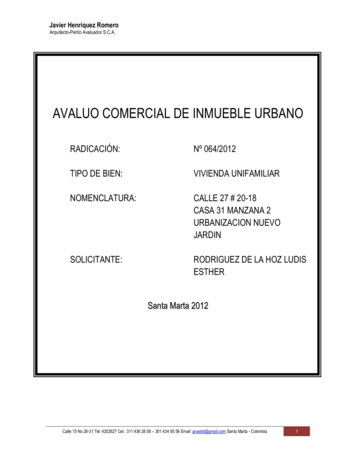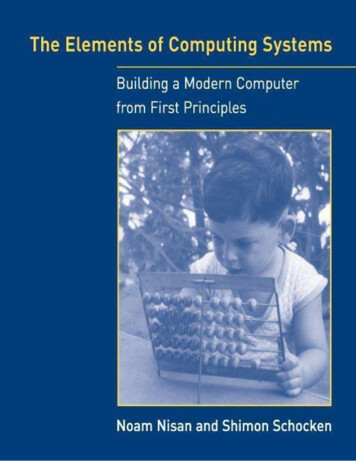
Transcription
Table of ContentsTitle PageCopyright PageDedicationPrefaceIntroductionChapter 1 - Boolean Logic1.1 Background1.2 Specification1.3 Implementation1.4 Perspective1.5 ProjectChapter 2 - Boolean Arithmetic2.1 Background2.2 Specification2.3 Implementation2.4 Perspective2.5 ProjectChapter 3 - Sequential Logic3.1 Background3.2 Specification3.3 Implementation3.4 Perspective3.5 ProjectChapter 4 - Machine Language4.1 Background4.2 Hack Machine Language Specification4.3 Perspective4.4 ProjectChapter 5 - Computer Architecture5.1 Background5.2 The Hack Hardware Platform Specification5.3 Implementation5.4 Perspective5.5 Project
Chapter 6 - Assembler6.1 Background6.2 Hack Assembly-to-Binary Translation Specification6.3 Implementation6.4 Perspective6.5 ProjectChapter 7 - Virtual Machine I: Stack Arithmetic7.1 Background7.2 VM Specification, Part I7.3 Implementation7.4 Perspective7.5 ProjectChapter 8 - Virtual Machine II: Program Control8.1 Background8.2 VM Specification, Part II8.3 Implementation8.4 Perspective8.5 ProjectChapter 9 - High-Level Language9.1 Background9.2 The Jack Language Specification9.3 Writing Jack Applications9.4 Perspective9.5 ProjectChapter 10 - Compiler I: Syntax Analysis10.1 Background10.2 Specification10.3 Implementation10.4 Perspective10.5 ProjectChapter 11 - Compiler II: Code Generation11.1 Background11.2 Specification11.3 Implementation11.4 Perspective
11.5 ProjectChapter 12 - Operating System12.1 Background12.2 The Jack OS Specification12.3 Implementation12.4 Perspective12.5 ProjectChapter 13 - Postscript: More Fun to Go13.1 Hardware Realizations13.2 Hardware Improvements13.3 High-Level Languages13.4 Optimizations13.5 CommunicationsAppendix A: - Hardware Description Language (HDL)Appendix B: - Test Scripting LanguageIndex
2005 Massachusetts Institute of TechnologyAll rights reserved. No part of this book may be reproduced in any form by any electronic or mechanical means (including photocopying,recording, or information storage and retrieval) without permission in writing from the publisher.This book was set in Times New Roman on 3B2 by Asco Typesetters, Hong Kong.Printed and bound in the United States of America.Library of Congress Cataloging-in-Publication DataNisan, Noam.The elements of computing systems: building a modern computer from first principles / Noam Nisan and Shimon Schocken.p. cm.Includes bibliographical references and index.ISBN 0-262-14087-X (alk. paper)1. Electronic digital computers. I. Schocken, Shimon. II. Title.TK7888.3.N57 2005004.16—dc22200504280710 9 8 7 6 5 4 3 2 1Note on SoftwareThe book’s Web site (http://www.idc.ac.il/tecs) provides the tools and materials necessary to build all the hardware and software systemsdescribed in the book. These include a hardware simulator, a CPU emulator, a VM emulator, and executable versions of the assembler, virtualmachine, compiler, and operating system described in the book. The Web site also includes all the project materials—about 200 test programsand test scripts, allowing incremental development and unit-testing of each one of the 12 projects. All the supplied software tools and projectmaterials can be used as is on any computer equipped with either Windows or Linux.
To our parents,For teaching us that less is more.
PrefaceWhat I hear, I forget; What I see, I remember; What I do, I understand.—Confucius, 551-479 BCOnce upon a time, every computer specialist had a gestalt understanding of how computers worked. Theoverall interactions among hardware, software, compilers, and the operating system were simple andtransparent enough to produce a coherent picture of the computer’s operations. As modern computertechnologies have become increasingly more complex, this clarity is all but lost: the most fundamentalideas and techniques in computer science—the very essence of the field—are now hidden under manylayers of obscure interfaces and proprietary implementations. An inevitable consequence of thiscomplexity has been specialization, leading to computer science curricula of many courses, each coveringa single aspect of the field.We wrote this book because we felt that many computer science students are missing the forest for thetrees. The typical student is marshaled through a series of courses in programming, theory, andengineering, without pausing to appreciate the beauty of the picture at large. And the picture at large issuch that hardware and software systems are tightly interrelated through a hidden web of abstractions,interfaces, and contract-based implementations. Failure to see this intricate enterprise in the flesh leavesmany students and professionals with an uneasy feeling that, well, they don’t fully understand what’sgoing on inside computers.We believe that the best way to understand how computers work is to build one from scratch. With thatin mind, we came up with the following concept. Let’s specify a simple but sufficiently powerfulcomputer system, and have the students build its hardware platform and software hierarchy from theground up, starting with nothing more than elementary logic gates. And while we are at it, let’s do it right.We say this because building a general-purpose computer from first principles is a huge undertaking.Therefore, we identified a unique educational opportunity not only to build the thing, but also to illustrate,in a hands-on fashion, how to effectively plan and manage large-scale hardware and softwaredevelopment projects. In addition, we sought to demonstrate the ability to construct, through recursiveascent and human reasoning, fantastically complex and useful systems from nothing more than a fewprimitive building blocks.
ScopeThe book exposes students to a significant body of computer science knowledge, gained through a seriesof hardware and software construction tasks. These tasks demonstrate how theoretical and appliedtechniques taught in other computer science courses are used in practice. In particular, the followingtopics are illustrated in a hands-on fashion: Hardware: Logic gates, Boolean arithmetic, multiplexors, flip-flops, registers, RAM units, counters,Hardware Description Language (HDL), chip simulation and testing. Architecture: ALU/CPU design and implementation, machine code, assembly language programming,addressing modes, memory-mapped input/output (I/O). Operating systems: Memory management, math library, basic I/O drivers, screen management, file I/O,high-level language support. Programming languages: Object-based design and programming, abstract data types, scoping rules,syntax and semantics, references. Compilers: Lexical analysis, top-down parsing, symbol tables, virtual stack-based machine, codegeneration, implementation of arrays and objects. Data structures and algorithms: Stacks, hash tables, lists, recursion, arithmetic algorithms, geometricalgorithms, running time considerations. Software engineering: Modular design, the interface/implementation paradigm, API design anddocumentation, proactive test planning, programming at the large, quality assurance.All these topics are presented with a very clear purpose: building a modern computer from the groundup. In fact, this has been our topic selection rule: The book focuses on the minimal set of topics necessaryfor building a fully functioning computer system. As it turns out, this set includes many fundamental ideasin applied computer science.
CoursesThe book is intended for students of computer science and other engineering disciplines in colleges anduniversities, at both the undergraduate and graduate levels. A course based on this book is“perpendicular” to the normal computer science curriculum and can be taken at almost any point duringthe program. Two natural slots are “CS-2”—immediately after learning programming, and “CS-199”—acapstone course coming at the end of the program. The former course can provide a systems-orientedintroduction to computer science, and the latter an integrative, project-oriented systems building course.Possible names for such courses may be Constructive Introduction to Computer Science, Elements ofComputing Systems, Digital Systems Construction, Computer Construction Workshop, Let’s Build aComputer, and the like. The book can support both one- and two-semester courses, depending on topicselection and pace of work.The book is completely self-contained, requiring only programming (in any language) as a prerequisite.Thus, it lends itself not only to computer science majors, but also to computer-savvy students seeking togain a hands-on view of hardware architectures, operating systems, and modern software engineering inthe framework of one course. The book and the accompanying Web site can also be used as a self-studylearning unit, suitable to students from any technical or scientific discipline following a programmingcourse.
StructureThe introduction chapter presents our approach and previews the main hardware and softwareabstractions discussed in the book. This sets the stage for chapters 1-12, each dedicated to a keyhardware or software abstraction, a proposed implementation, and an actual project that builds and testsit. The first five chapters focus on constructing the hardware platform of a simple modern computer. Theremaining seven chapters describe the design and implementation of a typical multi-tier softwarehierarchy, culminating in the construction of an object-based programming language and a simpleoperating system. The complete game plan is depicted in figure P.1.The book is based on an abstraction-implementation paradigm. Each chapter starts with a Backgroundsection, describing relevant concepts and a generic hardware or software system. The next section isalways Specification, which provides a clear statement of the system’s abstraction—namely, the variousservices that it is expected to deliver. Having presented the what, each chapter proceeds to discuss howthe abstraction can be implemented, leading to a (proposed) Implementation section. The next section isalways Perspective, in which we highlight noteworthy issues left out from the chapter. Each chapter endswith a Project section that provides step-by-step building instructions, testing materials, and softwaretools for actually building and unit-testing the system described in the chapter.Figure P.1 Book and proposed course map, with chapter numbers in circles.
ProjectsThe computer system described in the book is for real—it can actually be built, and it works! A readerwho takes the time and effort to gradually build this computer will gain a level of intimate understandingunmatched by mere reading. Hence, the book is geared toward active readers who are willing to roll uptheir sleeves and build a computer from the ground up.Each chapter includes a complete description of a stand-alone hardware or software developmentproject. The four projects that construct the computer platform are built using a simple HardwareDescription Language (HDL) and simulated on a hardware simulator supplied with the book. Five of thesubsequent software projects (assembler, virtual machine I and II, and compiler I and II) can be written inany modern programming language. The remaining three projects (low-level programming, high-levelprogramming, and the operating system) are written in the assembly language and high-level languageimplemented in previous projects.Project Tips There are twelve projects altogether. On average, each project entails a weekly homeworkload in a typical, rigorous university-level course. The projects are completely self-contained and can bedone (or skipped) in any desired order. Of course the “full experience” package requires doing all theprojects in their order of appearance, but this is just one option.When we teach courses based on this book, we normally make two significant concessions. First,except for obvious cases, we pay no attention to optimization, leaving this very important subject to other,more specific courses. Second, when developing the translators suite (assembler, VM implementation,and compiler), we supply error-free test files (source programs), allowing the students to assume that theinputs of these translators are error-free. This eliminates the need to write code for handling errors andexceptions, making the software projects significantly more manageable. Dealing with incorrect input isof course critically important, but once again we assume that students can hone this skill elsewhere, forexample, in dedicated programming and software design courses.
SoftwareThe book’s Web site ( www.idc.ac.il/tecs) provides the tools and materials necessary to build all thehardware and software systems described in the book. These include a hardware simulator, a CPUemulator, a VM emulator, and executable versions of the assembler, virtual machine, compiler, andoperating system described in the book. The Web site also includes all the project materials—about twohundred test programs and test scripts, allowing incremental development and unit-testing of each one ofthe twelve projects. All the supplied software tools and project materials can be used as is on anycomputer equipped with either Windows or Linux.
AcknowledgmentsAll the software that accompanies the book was developed by our students at the Efi Arazi School ofComputer Science of the Interdisciplinary Center Herzliya, a new Israeli university. The chief softwarearchitect was Yaron Ukrainitz, and the developers included Iftach Amit, Nir Rozen, Assaf Gad, andHadar Rosen-Sior. Working with these student-developers has been a great pleasure, and we feel proudand fortunate to have had the opportunity to play a role in their education. We also wish to thank ourteaching assistants, Muawyah Akash, David Rabinowitz, Ran Navok, and Yaron Ukrainitz, who helped usrun early versions of the course that led to this book. Thanks also to Jonathan Gross and Oren Baranes,who worked on related projects under the excellent supervision of Dr. Danny Seidner, to Uri Zeira andOren Cohen, for designing an integrated development environment for the Jack language, to Tal Achituv,for useful advice on open source issues, and to Aryeh Schnall, for careful reading and meticulous editingsuggestions.Writing the book without taking any reduction in our regular professional duties was not simple, and sowe wish to thank esti romem, administrative director of the EFI Arazi School of Computer Science, forholding the fort in difficult times. Finally, we are indebted to the many students who endured earlyversions of this book and helped polish it through numerous bug reports. In the process, we hope, theyhave learned first-hand that insight of James Joyce, that mistakes are the portals of discovery.Noam NisanShimon Schocken
Figure I.1 The major abstractions underlying the design of a typical computing system. Theimplementation of each level is accomplished using abstract services and building blocks from the levelbelow.Introduction: Hello, World BelowThe true voyage of discovery consists not of going to new places, but of having a new pair of eyes.—Marcel Proust (1871-1922)This book is a voyage of discovery. You are about to learn three things: how computers work, how to
break complex problems into manageable modules, and how to develop large-scale hardware andsoftware systems. This will be a hands-on process as you create a complete and working computer systemfrom the ground up. The lessons you will learn, which are far more important and general than thecomputer itself, will be gained as side effects of this activity. According to the psychologist Carl Rogers,“the only kind of learning which significantly influences behavior is self-discovered or self-appropriated—truth that has been assimilated in experience.” This chapter sketches some of the discoveries, truths,and experiences that lie ahead.
The World AboveIf you have taken any programming course, you’ve probably encountered something like the programbelow early in your education. This particular program is written in Jack—a simple high-level languagethat has a conventional object-based syntax.Trivial programs like Hello World are deceptively simple. Did you ever think about what it takes toactually run such a program on a computer? Let’s look under the hood. For starters, note that the programis nothing more than a bunch of dead characters stored in a text file. Thus, the first thing we must do isparse this text, uncover its semantics, and reexpress it in some low-level language understood by ourcomputer. The result of this elaborate translation process, known as compilation, will be yet another textfile, containing machine-level code.Of course machine language is also an abstraction—an agreed upon set of binary codes. In order tomake this abstract formalism concrete, it must be realized by some hardware architecture. And thisarchitecture, in turn, is implemented by a certain chip set—registers, memory units, ALU, and so on.Now, every one of these hardware devices is constructed from an integrated package of elementary logicgates. And these gates, in turn, can be built from primitive gates like Nand and Nor. Of course every oneof these gates consists of several switching devices, typically implemented by transistors. And eachtransistor is made of—Well, we won’t go further than that, because that’s where computer science endsand physics starts.You may be thinking: “On my computer, compiling and running a program is much easier—all I have todo is click some icons or write some commands!” Indeed, a modern computer system is like a hugeiceberg, and most people get to see only the top. Their knowledge of computing systems is sketchy andsuperficial. If, however, you wish to explore beneath the surface, then lucky you! There’s a fascinatingworld down there, made of some of the most beautiful stuff in computer science. An intimateunderstanding of this underworld is one of the things that separate naïve programmers from sophisticateddevelopers—people who can create not only application programs, but also complex hardware andsoftware technologies. And the best way to understand how these technologies work—and we meanunderstand them in the marrow of your bones—is to build a complete computer system from scratch.
AbstractionsYou may wonder how it is humanly possible to construct a complete computer system from the ground up,starting with nothing more than elementary logic gates. This must be an enormously complex enterprise!We deal with this complexity by breaking the project into modules, and treating each module separately,in a stand-alone chapter. You might then wonder, how is it possible to describe and construct thesemodules in isolation? Obviously they are all interrelated! As we will show throughout the book, a goodmodular design implies just that: You can work on the individual modules independently, whilecompletely ignoring the rest of the system. In fact, you can even build these modules in any desired order!It turns out that this strategy works well thanks to a special gift unique to humans: our ability to createand use abstractions. The notion of abstraction, central to many arts and sciences, is normally taken to bea mental expression that seeks to separate in thought, and capture in some concise manner, the essence ofsome entity. In computer science, we take the notion of abstraction very concretely, defining it to be astatement of “what the entity does” and ignoring the details of “how it does it.” This functional descriptionmust capture all that needs to be known in order to use the entity’s services, and nothing more. All thework, cleverness, information, and drama that went into the entity’s implementation are concealed fromthe client who is supposed to use it, since they are simply irrelevant. The articulation, use, andimplementation of such abstractions are the bread and butter of our professional practice: Every hardwareand software developer is routinely defining abstractions (also called “interfaces”) and thenimplementing them, or asking other people to implement them. The abstractions are often built layer uponlayer, resulting in higher and higher levels of capabilities.Designing good abstractions is a practical art, and one that is best acquired by seeing many examples.Therefore, this book is based on an abstraction-implementation paradigm. Each book chapter presents akey hardware or software abstraction, and a project designed to actually implement it. Thanks to themodular nature of these abstractions, each chapter also entails a stand-alone intellectual unit, inviting thereader to focus on two things only: understanding the given abstraction (a rich world of its own), and thenimplementing it using abstract services and building blocks from the level below. As you push ahead inthis journey, it will be rather thrilling to look back and appreciate the computer that is gradually takingshape in the wake of your efforts.
The World BelowThe multi-tier collection of abstractions underlying the design of a computing system can be describedtop-down, showing how high-level abstractions can be reduced into, or expressed by, simpler ones. Thisstructure can also be described bottom-up, focusing on how lower-level abstractions can be used toconstruct more complex ones. This book takes the latter approach: We begin with the most basic elements—primitive logic gates—and work our way upward, culminating in the construction of a general-purposecomputer system. And if building such a computer is like climbing Mount Everest, then planting a flag onthe mountaintop is like having the computer run a program written in some high-level language. Since weare going to ascend this mountain from the ground up, let us survey the book plan in the opposite direction—from the top down—starting in the familiar territory of high-level programming.Our tour consists of three main legs. We start at the top, where people write and run high-levelprograms (chapters 9 and 12). We then survey the road down to hardware land, tracking the fascinatingtwists and curves of translating high-level programs into machine language (chapters 6, 7, 8, 10, 11).Finally, we reach the low grounds of our journey, describing how a typical hardware platform is actuallyconstructed (chapters 1-5).
High-Level Language LandThe topmost abstraction in our journey is the art of programming, where entrepreneurs and programmersdream up applications and write software that implements them. In doing so, they blissfully take forgranted the two key tools of their trade: the high-level language in which they work, and the rich library ofservices that supports it. For example, consider the statement do Output.printString(ʹ ʹHello Worldʹ ʹ ).This code invokes an abstract service for printing strings—a service that must be implementedsomewhere. Indeed, a bit of drilling reveals that this service is usually supplied jointly by the hostoperating system and the standard language library.What then is a standard language library? And how does an operating system (OS) work? Thesequestions are taken up in chapter 12. We start by presenting key algorithms relevant to OS services, andthen use them to implement various mathematical functions, string operations, memory allocation tasks,and input/output (I/O) routines. The result is a simple operating system, written in the Jack programminglanguage.Jack is a simple object-based language, designed for a single purpose: to illustrate the key softwareengineering principles underlying the design and implementation of modern programming languages likeJava and C#. Jack is presented in chapter 9, which also illustrates how to build Jack-based applications,for example, computer games. If you have any programming experience with a modern object-orientedlanguage, you can start writing Jack programs right away and watch them execute on the computerplatform developed in previous chapters. However, the goal of chapter 9 is not to turn you into a Jackprogrammer, but rather to prepare you to develop the compiler and operating system described insubsequent chapters.
The Road Down to Hardware LandBefore any program can actually run and do something for real, it must be translated into the machinelanguage of some target computer platform. This compilation process is sufficiently complex to be brokeninto several layers of abstraction, and these usually involve three translators: a compiler, a virtualmachine implementation, and an assembler. We devote five book chapters to this trio, as follows.The translation task of the compiler is performed in two conceptual stages: syntax analysis and codegeneration. First, the source text is analyzed and grouped into meaningful language constructs that can bekept in a data structure called a “parse tree.” These parsing tasks, collectively known as syntax analysis,are described in chapter 10. This sets the stage for chapter 11, which shows how the parse tree can berecursively processed to yield a program written in an intermediate language. As with Java and C#, theintermediate code generated by the Jack compiler describes a sequence of generic steps operating on astack-based virtual machine (VM). This classical model, as well as a VM implementation that realizes iton an actual computer, are elaborated in chapters 7-8. Since the output of our VM implementation is alarge assembly program, we have to translate it further into binary code. Writing an assembler is arelatively simple task, taken up in chapter 6.
Hardware LandWe have reached the most profound step in our journey—the descent from machine language to themachine itself—the point where software finally meets hardware. This is also the point where Hackenters the picture. Hack is a general-purpose computer system, designed to strike a balance betweensimplicity and power. On the one hand, the Hack architecture can be built in just a few hours of work,using the guidelines and chip set presented in chapters 1-3. At the same time, Hack is sufficiently generalto illustrate the key operating principles and hardware elements underlying the design of any digitalcomputer.The machine language of the Hack platform is specified in chapter 4, and the computer design itself isdiscussed and specified in chapter 5. Readers can build this computer as well as all the chips and gatesmentioned in the book on their home computers, using the software-based hardware simulator suppliedwith the book and the Hardware Description Language (HDL) documented in appendix A. All thedeveloped hardware modules can be tested using supplied test scripts, written in a scripting languagedocumented in appendix B.The computer that emerges from this construction is based on typical components like CPU, RAM,ROM, and simulated screen and keyboard. The computer’s registers and memory systems are built inchapter 3, following a brief discussion of sequential logic. The computer’s combinational logic,culminating in the Arithmetic Logic Unit (ALU) chip, is built in chapter 2, following a brief discussion ofBoolean arithmetic. All the chips presented in these chapters are based on a suite of elementary logicgates, presented and built in chapter 1.Of course the layers of abstraction don’t stop here. Elementary logic gates are built from transistors,using technologies based on solid-state physics and ultimately quantum mechanics. Indeed, this is wherethe abstractions of the natural world, as studied and formulated by physicists, become the building blocksof the abstractions of the synthetic worlds built and studied by computer scientists.This marks the end of our grand tour preview—the descent from the high-level peaks of object-basedsoftware, all the way down to the bricks and mortar of the hardware platform. This typical modularrendition of a multi-tier system represents not only a powerful engineering paradigm, but also a centraldogma in human reasoning, going back at least 2,500 years:We deliberate not about ends, but about means. For a doctor does not deliberate whether he shallheal, nor an orator whether he shall persuade . They assume the end and consider how and by whatmeans it is attained, and if it seems easily and best produced thereby; while if it is achieved by othermeans, they consider how it will be achieved and by what means this will be achieved, until they cometo the first cause . and what is last in the order of analysis seems to be first in the order of becoming.(Aristotles, Nicomachean Ethics, Book III, 3, 1112b)So here’s the plan, in the order of becoming. Starting with the construction of elementary logic gates(chapter 1), we go bottom-up to combinational and sequential chips (chapters 2-3), through the design of atypical computer architecture (chapters 4-5) and a typical software hierarchy (chapters 6-8), all the wayto implementing a compiler (chapters 10-11) for a modern object-based language (chapter 9), ending withthe design and implementation of a simple operating system (chapter 12). We hope that the reader hasgained a general idea of what lies ahead and is eager to push forward on this grand tour of discovery. So,assuming that you are ready and set, let the countdown start: 1, 0, Go!
1Boolean LogicSuch simple things, And we make of them something so complex it defeats us, Almost.—John Ashbery (b. 1927), American poetEvery digital device—be it a personal computer, a cellular telephone, or a network router—is based on aset of chips designed to store and process information. Although these chips come in different shapes andforms, they are all made from the same building blocks: Elementary logic gates. The gates can bephysically implemented in many different materials and fabrication technologies, but their logicalbehavior is consistent across all computers. In this chapter we start out with one primitive logic gate—Nand—and build all the other logic gates from it. The result is a rather standard set of gates,
Computer, and the like. The book can support both one- and two-semester courses, depending on topic selection and pace of work. The book is completely self-contained, requiring only programming (in any language) as a prerequisite. Thus, it lends itself not only to computer science majors, but al






